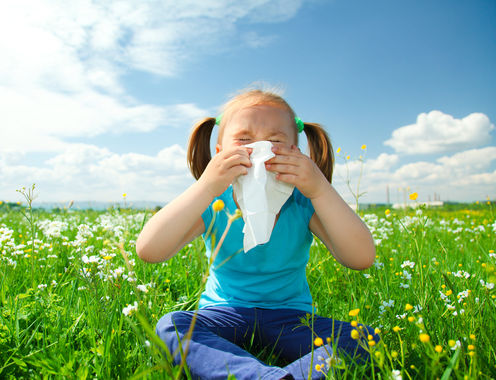
It’s now late spring, with summer just around the corner, and many people with hay fever suffer at this time of year in Australia. Although the cause of this suffering is invisible to us, it is actually all around us — plant pollen floating in the air.
The 500 million people in the world who suffer from allergies may be alarmed to learn that the major global outdoor allergen, grass pollen, is likely to significantly increase with climate change. In fact the latest research from the US shows that if there’s twice as much CO2 in the atmosphere there could be three times as much grass pollen allergen in the air.
Plants are sensitive to the climate. Rain provides them with water, and the seasonal changes in temperature lead to flowering. Plants are also sensitive to the different gases in the air that surrounds them. One of these gases is carbon dioxide, the same gas that our activities are increasing as each year goes by.
Climate change, especially the gradual increase in the global air temperature, and the increase in carbon dioxide, are causing changes in the pollen that we breathe. The pollen season is changing, starting earlier and going for longer. There is also more pollen in the air than there used to be.
While some scientists around the world are measuring the pollen and the amount of allergen within the pollen in the air and are already detecting these changes, others are doing experiments that tell us what the future will be like.
Latest research
The newest of these experiments, by a team of scientists from Harvard University and the University of Massachusetts in the US, has shown us one more piece of the puzzle — what happens to grass pollen when grass grows under higher levels of carbon dioxide and higher levels of another important gas, ozone, which slows plant growth?
Experiments like this that examine the effects of not just one but two future changes in the air are very important because they better reflect the complex environment in which plants grow.
These results provide cause for concern. The team, led by Harvard’s Jennifer Albertine, found that Timothy grass grown in the future elevated carbon dioxide and ozone produced more pollen, with more pollen allergen overall. The amount of allergen within pollen is not always the same, and may be affected by CO2 and ozone levels.
Indeed, even with the increased ozone level working against the pollen stimulation by increased carbon dioxide, more than twice as much pollen was produced by the plants, and the overall allergen content increased by 48%. This would mean that hay fever sufferers in the future are exposed to more grass pollen and more grass pollen allergen.
Whilst Timothy grass is rare in Australia, similar types of temperate grasses such as Ryegrass, Cocksfoot, Canary and Kentucky Blue grass, are common in Victoria, Tasmania as well as parts of South Australia, New South Wales and Western Australia.
It is possible that these types of temperate grasses will also respond in a similar way to produce more pollen allergen with climate change.
Grasses moving south
However, a number of subtropical grasses such as Bermuda (couch), Rhodes, Bahia and Johnson grasses, are abundant in warmer regions of Australia such as Queensland and northern parts of New South Wales. As yet, there has been no research on how the pollen or allergen count of these grasses will be affected by climate change.
For those who have hay fever, the immune system can tell the difference between subtropical and temperate grass pollens, meaning that some people may need separate diagnosis and treatment for subtropical and temperate grass pollen allergy. The response to climate change of subtropical grasses as well as temperate grasses will be important for Australia.
There are increasing concerns about the impact of climate change on allergies in Australia because subtropical grasses are likely to extend their range further south. This is important because many species of subtropical grasses flower in summer which can lengthen the grass pollen allergy season.
Previous US research, showed that at higher CO2 levels, subtropical grasses grow better than temperate grasses and are likely to thrive with climate change, even in temperate regions.
Grass pollen in the air can also be a trigger of asthma. When grass pollen levels are high just before a thunderstorm, epidemics of asthma can happen. With climate change, we will also need to be prepared for more extreme weather events such as thunderstorms.
To better manage pollen allergies in Australia now and in the future we need to understand the regional differences in levels of pollen, types of grasses making pollen, and the amount of pollen allergen in the air.
To address these key gaps in what we know about pollen allergies nationally, we plan to establish the Australian Pollen Allergen Partnership, which will build upon early work of the Australian Aerobiology Working Group
The picture is now pretty clear, climate change is harming hay fever sufferers, and will continue to do so.
Janet Davies receives funding from the National Health and Medical Research Council, The University of Queensland and The Princess Alexandra Hospital Foundation. She has consults to Stallergenes Pty Ltd and has received Honorarium from Glaxo Smith Kline and in kind research support from ThermoFisher (Sweden) and Sullivan Nicolaides Pathology (Australia). The Australian Aerobiology Working Group was supported by the Australian Center for Ecological Analysis and Synthesis and co-sponsored by untied funds from Merck Sharp and Dohme.
Paul Beggs receives funding from New South Wales (NSW) Environmental Trust (NSW Government). The Australian Aerobiology Working Group was supported by the Australian Centre for Ecological Analysis and Synthesis and co-sponsored by untied funds from Merck Sharp and Dohme.
